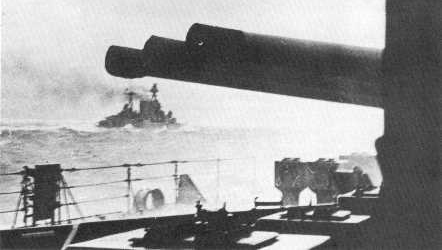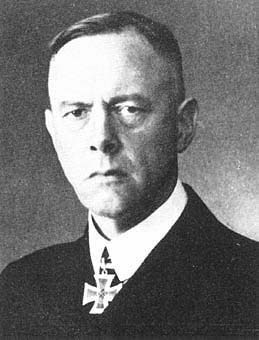'Closer, Get Closer Yet to the Bismarck!'
The War Illustrated, Volume 4, No. 95, Page 630, June 27, 1941.
From 8.30 on the evening of May 26 until it was all over at about noon the next day – until, that is, the Bismarck had been fought to a finish and sent to the bottom – the officer whose story we give below was on the bridge of the King George V, Admiral Tovey's flagship. The official Admiralty account of the action appears in page 580, and other descriptions and illustrations will be found in pages 582, 583, 612-613, and 645.
Throughout the night on the Admiral's bridge of the King George V we sat, stood, or leant like a covey of disembodied spirits. It was dark, windy, rainy.
None of us will ever know if it was cold. About two o'clock in the morning cocoa appeared. We drank it gratefully, but it might equally well have been pitch-tar; none would have noticed.
At last daylight, patchy rain squalls, a flickering sun, a tearing wind from the northwest and a rising sea. A little manoeuvring and then on tin hats. Norfolk appears to the eastward: "Enemy in sight twelve miles to the south of me", she says. A little change of course; Rodney opens out to port a little more. "Enemy in sight." Well, I couldn't see him; it is the aloft gun director who can see him. And then, veiled in distant rainfall, is a thick squat ghost of a ship, very broad in the beam, coming straight towards us, end on.
There is a sudden shift of wind and a squall of rain dashes across. The Commander-in-Chief, Admiral Tovey, saw it first and was giving orders to alter the course. He put on his tin hat, and out poured a little cascade of water all over him. He just grinned, quite undisturbed by that or, indeed, by any other incident of his five-day chase, which his brilliant judgement and leadership brought to a close in triumphant battle.
There is a sort of cracking roar to port: the Rodney has opened fire with her 16-inch guns, and an instant later the King George V lets fly her 14-inch. The compass bounds out of its binnacle; my battle bowler tips over my nose and clatters down to the deck; and a pile of signal papers shoots up like a fountain and swirls away in the tearing draught made by the great guns.
I have my glasses on Bismarck. She fires all four guns from her two forward turrets, four thin orange flames. The Germans have a reputation for hitting with their early salvos. Now I know what suspended animation means. It seems to take about two hours for those shots to fall! The splashes shoot up opposite but beyond Rodney's fo'c'sle. I'm sorry to say that we all thought, "Thank heavens she's shooting at Rodney". My second thought was that I wouldn't care to be facing nine 16-inch and ten 14-inch guns; I just kept my binoculars glued to Bismarck. Rodney's first salvo produced great white columns of water 120 ft. high that would break the back of a destroyer and sink her like a tone if she steamed through one of them.
Rodney's Deadly Fire
The second splash I missed – all except one shot which seemed to belong to King George V and was a little ahead of Bismarck. Then I watched Rodney to see if she was being hit, but she just sat there like a great slab of rock blocking the northern horizon, and suddenly belched a full salvo. I actually saw there projectiles flying through the air for some seconds after they left the guns like little diminishing footballs curving up and up into the sky. Now, I am sure that four or five hit. There was only one great splash, and a sort of flurry of spray and splash which might have been a waterline hit. The others had bored their way through the Krupp armour belt like cheese; and pray God I may never know what they did as they exploded inside the hull.
Bismarck turned north, steaming about twelve or fourteen knots. We kept turning in and out to confuse the enemy rangetakers, all the while closing the range rapidly. The Admiral kept on saying, "Close the range; get closer; get closer. I can't see enough hits!" And so we closed the range.
But although you couldn't see the hits they were there right enough. Somewhere about the eight salvo there was a fire on the fo'c'sle which seemed to envelop the upper turret, and one observer tells me he saw a huge plate torn away from the tail of it. She turned away, then back, writhing it seemed, under the most merciless hail of high-explosive armour-piercing shells that any ship has, I suppose, ever faced. There was no escape for Bismarck; our fellows just went on pumping it out in a steady succession of shattering roars.
Smoke shot up, perhaps in an endeavour to screen herself, but it quickly blew away. And then I noticed her two rear turrets firing at us. There was a sort of shudder somewhere in our stern and I glanced that way for a hit – but there was no sign of it. A little later I heard the first whine of her 15-inch shell; it was s straddling shot over our fo'c'sle, one short and three overs. I wondered if the next would hit, and found myself edging into the doorway at the back of the bridge. It wouldn't have helped very much; it is only splash-proof plating, so I stepped forward again to see how Bismarck was getting along.
And an extraordinary sight met my eyes. The action had been going perhaps twenty minutes; some of her secondary armament and certainly two of the great turrets were still firing, perhaps a little wildly, for nobody on our side showed signs of a hit. There, racing across her quarterdeck were little human figures; one climbed over the wire guard rails, hung on with one hand, looked back, and then jumped into the sea. Others just jumped without looking back at all – a little steady trickle of them jumping into the sea one after another.
'Lurching Black Ruin'
About this time the coppery glow of our secondary armament shells striking the armoured upper works became more and more frequent, and one fierce flame shot up from the base of the bridge structure enveloping it as high as and including the spotting top for a flickering second. Every man there must have been incinerated. There was no smoke; the heat had consumed it. Once I saw evidently a small-calibre shell afire, for a swift arc of flame shot high into the air and curved over the top of the mainmast. She still kept up some speed, but seemed heavy in the water and had a slight list to port.
Well, we just shot the guns out of her and left a smoking, lurching black ruin. It made one feel a little sick to see such a mighty powerful vessel brought to the state on an impotent hulk. Only her slow, wallowing speed seemed still to give her life, and those little jumping figures at the stern. It was like a dog that has been run over; someone had got to finish him off – because her colours are still flying at the mainmast head.
Our battleships turned away, and Dorsetshire closed in and finished her off with torpedoes. When we were about ten miles off, the hulk turned over to port, floated for a little bottom up, and then, with a lift of the bows, was suddenly gone.
Previous and next article from The Bismarck and The Hood
I Was There! - I Saw One Vast Explosion - The Hood Had Gone
The end of the 'mighty Hood' was described as an almost unbelievable nightmare by Reuter's special correspondent, who was on the bridge of one of our warships when the Hood went down with her guns sti
I Was There! - We Helped in the Sinking of the Bismarck
The terrible punishment which the Bismarck withstood before she was finally torpedoed and the rescue of a hundred or so survivors from the great German warship are described by British naval officers
Index
Previous article
I Was There! - I Saw One Vast Explosion - The Hood Had Gone
The end of the 'mighty Hood' was described as an almost unbelievable nightmare by Reuter's special correspondent, who was on the bridge of one of our warships when the Hood went down with her guns sti
Next article
I Was There! - We Helped in the Sinking of the Bismarck
The terrible punishment which the Bismarck withstood before she was finally torpedoed and the rescue of a hundred or so survivors from the great German warship are described by British naval officers





